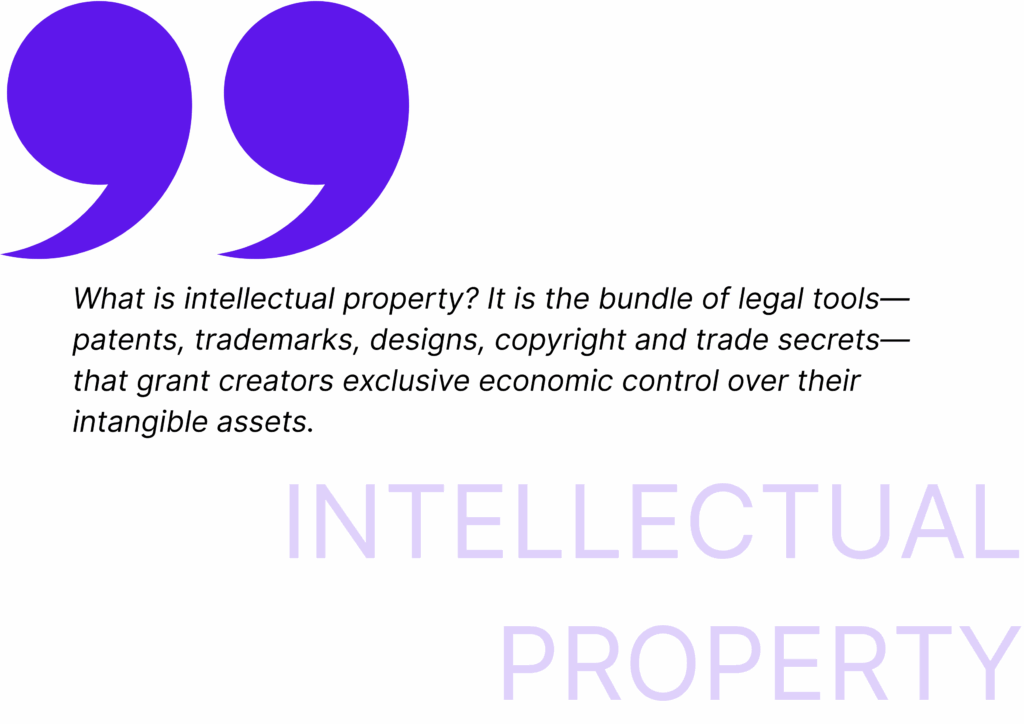What is intellectual property? It is the bundle of legal tools—patents, trademarks, designs, copyright and trade secrets—that grant creators exclusive economic control over their intangible assets.
What is intellectual property in Europe
However, European law does not create one single “IP right”; instead, it offers a cafeteria menu. A patent protects a technical invention for up to 20 years if granted by the European Patent Office (see EPO). A European Union trade mark lasts indefinitely subject to renewal, whereas a Community design right shields product appearance for up to 25 years. Copyright arises automatically without registration. Trade Secrets Directive 2016/943 obliges firms to adopt “reasonable steps” to keep valuable know‑how confidential; courts refuse relief where secrecy measures are absent.
Notably, each branch has its own statute, fees and examination criteria. The Patent Cooperation Treaty harmonises search and filing processes, but substantive grant remains with national authorities. That fragmented reality means entrepreneurs must map assets to jurisdictions early, rather than assume a pan‑European monopoly will magically appear.
Exclusive yet limited
Consequently, exclusive rights are territorially bounded: a French INPI patent gives no cover in Germany, and vice‑versa. Cross‑border ambitions call for either regional filings (EU trade mark, forthcoming Unitary Patent) or coordinated national applications. Ideas spark progress.
IP rights categories and scope
On balance, selecting the right instrument starts with classifying your asset. Does it solve a technical problem, identify origin or embellish appearance?
– Patents: novel, inventive technical solutions, examined by the EPO or national offices.
– Trade marks: signs that distinguish goods or services, registered at EUIPO or national level.
– Designs: outward shape or pattern, fast registration, minimal examination.
– Copyright: original creative expression—software included—automatic, 70 years post mortem.
– Trade secrets: commercially valuable information kept secret through documented measures.
In short, overlapping protection is often possible. A smartphone may contain patented circuitry, a registered trade mark logo and a copyrighted interface layout. The correct mix deters imitators and reassures investors.
Equally, scope differs: a patent stops anyone making, using or selling the invention, while a trade mark merely prevents confusingly similar branding. Mixing them without legal guidance courts disaster.

Critically, design protection is often overlooked by digital businesses. A user‑interface layout or an app icon can be registered as a Community design within 48 hours for €350 and blocks competitors cloning your look‑and‑feel. That speed beats patent grant by years and complements copyright, which is harder to enforce abroad.
Protecting innovation: patents, trademarks, trade secrets
Additionally, filing early is critical. Under the European Patent Convention, novelty is judged against everything made public anywhere before the filing date; one premature pitch deck can kill your patent. The same “first‑to‑file” principle drives trademark strategy—witness countless start‑ups forced to rebrand because someone else filed first. Why gamble? European Patent Office statistics show that 55 % of SMEs seeking venture capital present at least a pending patent application.
Furthermore, adequate disclosure matters. Patent applications must describe the invention in a way that enables a skilled person to reproduce it; vague marketing fluff will be refused. Trade secret programmes, by contrast, hinge on restricted access, NDAs, clean‑desk policies and cyber‑security logs. Courts interpret “reasonable steps” strictly—copy‑and‑paste security policies downloaded from the internet rarely suffice.
Consider a coffee‑capsule scale‑up: its patent covers the capsule geometry, its EU trade mark secures the brand name, and its flavour formula remains a trade secret with restricted lab access and non‑disclosure agreements. This layered shield makes copycats think twice.
Meanwhile, maintenance cannot be an afterthought. Patents lapse if annual renewal fees are missed; trade mark owners must prove genuine use after five years to avoid revocation. A simple docketing system or outsourced portfolio manager avoids costly oversights.
Key takeaway: File promptly, document secrecy and renew rights on schedule.
What is intellectual property strategy for startups
Consequently, resource‑constrained founders should prioritise registrations that align with revenue milestones. Do you plan to licence technology or sell branded goods? A staged approach—provisional patent, followed by EU trade mark once product‑market fit is proven—spreads cost and signals seriousness to investors.
Subsequently, deciding whom to hire is pivotal. A regulated European patent attorney handles technically complex filings; a trademark attorney focuses on brand clearance and classification. Their fees are dwarfed by litigation costs: EUIPO data show average cross‑border trademark disputes exceed €250 000 in legal and settlement outlays.
Importantly, IP due diligence is now routine even in seed rounds. Term‑sheet “IP reps and warranties” usually demand evidence that founders own all core technology, employees have signed assignment clauses, and no open‑source licences have been breached. Failure here torpedoes deals.
Decisively, embedding an IP culture inside the team pays long‑term dividends. Run onboarding sessions explaining why slide‑deck leaks jeopardise patents; label confidential files; restrict Git repository access. Investors routinely sample these processes during due diligence. Demonstrating that every intern knows confidentiality basics reassures backers that sensitive algorithms will not walk out the door.
Funding leverage
Finally, public schemes such as the EUIPO SME Fund reimburse up to 75 % of filing fees, while national R&D tax credits treat patent costs as deductible. Ignoring these incentives is pure waste. Ask yourself: will a €900 grant today unlock a €3 million seed round tomorrow?
Managing rights internationally
Meanwhile, the Madrid Protocol and the Patent Cooperation Treaty streamline overseas expansion. One international application can reserve rights in over 150 jurisdictions, buying 30 months to refine market choices. Yet enforcement remains national, so monitoring foreign registers is essential.
Otherwise, exporters often overlook packaging translation, risking distinctiveness loss. Have you already reserved the Chinese character version of your trade mark? Over‑the‑counter copycats thrive on such gaps.
Hence, performing an “IP road‑map” audit before launch avoids emergencies. Include customs recordals, local clearance searches and an exit‑ready licence package. Investors love preparation.
Moreover, EU customs are increasingly data‑driven. In 2024 the central IP Enforcement Portal handled 38 000 detentions, and linking it to the EU Safety and Security Manifest will make proactive interceptions easier. Registering your rights in the portal takes minutes and costs nothing.
Broadly, language and script variants matter. A Cyrillic transliteration of your Latin brand can be filed by third parties in Eastern Europe within days; recovering it later triggers expensive opposition proceedings. Filing defensive variants during Madrid designations costs little and signals expansion intent to partners.
Enforcement and infringement pitfalls
In short, registration is the opening move, not the endgame. Continuous watching services alert you to conflicting filings; customs applications allow border seizures of counterfeits. EU Regulation 608/2013 empowered customs to detain 66 million fake items in 2024 alone. Civil courts can order injunctions, damages and destruction, but only if evidence shows deliberate infringement.
Conversely, neglecting enforcement undermines valuation. Prompt cease‑and‑desist letters, mediation offers and, if necessary, litigation preserve both reputation and asset price. Yet proportionate action matters: aggressive tactics against legitimate resellers can backfire under EU competition law.
Nevertheless, alternative dispute resolution is gaining ground. The Unified Patent Court—operational since June 2023—offers pan‑European injunctions for unitary and classical European patents, reducing forum shopping. Mediation centres at WIPO and EUIPO resolve trade mark and design disputes within months at a fraction of court cost.
Ultimately, European criminal law also punishes large‑scale counterfeiting. Directive 2014/48/EU obliges Member States to impose criminal penalties where infringement is intentional and conducted on a commercial scale. Police raids, asset freezes and even custodial sentences remind would‑be infringers that IP theft can lead to prison walls, not merely civil damages.
Do I own intellectual property automatically?
Yes—copyright and trade secrets exist without registration, but patents, trade marks and designs require timely applications.
Can software be patented in Europe?
Only if it produces a “technical effect” beyond business logic; consult an attorney for borderline cases.
How much does a European patent cost?
Budget €5 000–€10 000 to grant, plus annual renewal fees per country. We advice to contact a specialist for an estimation of your total fee.
Can I sell my patent?
Absolutely; patents are transferable assets and can be sold outright or licensed for royalties.



